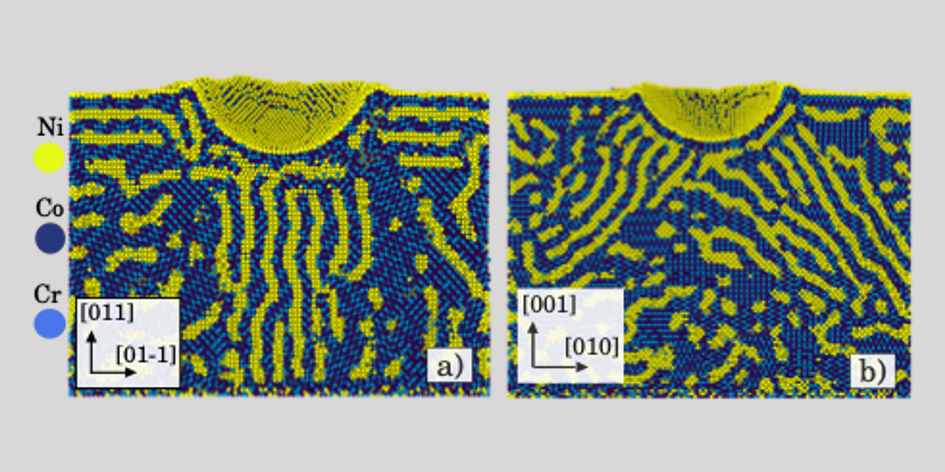
Simulations reveal surprising reorganization of the short-range order in nickel-cobalt-chromium alloys
25-03-2024
Scientists from the National Centre for Nuclear Research predict the possibility of ordering the structure of atoms in multicomponent alloys using point pressure on their surface. Until now, it was thought such arrangements could only be formed under the heat treatment. The team is now working to verify these simulations through experiments.
In standard modeling of metal alloys the ordering of the constituent atoms of the material is unknown. At the same time, short-range areas of arrangement in the chemical structure of alloy (CSRO – chemical short-range order), covering the size of several interatomic distances, can be the source of crucial properties, such as exceptional hardness or strength. This effect is caused by ordered structures – nanoscale atomic clusters, that could make it difficult or even impossible for defects in the material's structure to move.
Simulating an instrumental study of the hardness of a nickel-cobalt-chromium alloy (NiCoCr), a team of scientists from the NOMATEN Centre of Excellence (CoE) at the National Centre for Nuclear Research discovered, to their surprise, that nickel atoms can arrange themselves into chemically ordered structures as a result of such a process. Similar phenomena have been observed only under heat treatment, but simulations have shown that a point of pressure with a diamond blade (indenter) is enough to achieve the effect. This result is so important that a paper describing this achievement was published in March in the prestigious journal Physical Review Letters.
"In this study, we used computer simulations to explore how certain thermal treatments and nanomechanical probing techniques can influence the arrangement of atoms in multicomponent alloys, specifically NiCoCr alloys " - explains Amirhossein Naghdi, first author of the paper, a Ph.D. student at the CoE NOMATEN. - "We used computer simulations to explore how certain thermal treatments and nanomechanical probing techniques can influence the arrangement of atoms in multicomponent alloys, specifically NiCoCr alloys." Molecular simulations were based on well-known and repeatedly tested versions of interatomic potentials.
Modeling began with a simulation of the 'annealing' of a sample of a NiCoCr alloy with randomly distributed atoms of individual components to obtain a realistic initial state. Then, a diamond blade was "pressed" into the sample as part of the simulation. Once a certain depth was reached, the process was stopped, leaving the indenter stationary in the sample. In this state, changes occurring in the material were simulated using hybrid molecular dynamics processes and Monte Carlo methods. It has been discovered that under such conditions, nickel atoms separate from cobalt and chromium atoms, as a result of which they cease to be randomly located but organize themselves into a system of layers propagating under the indenter tip. This pattern remains in the alloy structure even after removing the indenter from the material. However, it does not occur if the prolonged application phase is omitted, i.e., during the usual pressure and immediate release process.
"These findings offer insights into how we can manipulate the properties of alloys at the atomic level, which could have implications for designing materials with tailored properties for various applications," adds Amirhossein Naghdi. In the future, the group wants to focus on combining experimental hardness testing with High-Resolution Transmission Electron Microscopy (HRTEM) to validate this phenomenon further. Future studies may determine whether the observed atomic distributions impact the properties of the alloy under study, which are essential for applications in materials design and engineering.
The NOMATEN Centre of Excellence is a scientific department established within NCBJ, thanks to the cooperation between NCBJ, CEA (France), and VTT (Finland) with the support of EU funds. It aims to conduct research and, as a result, obtain new materials resistant to high temperatures, corrosion, and radiation that can be used in industry and new radiopharmaceutical solutions. The achievement of the described results was possible thanks to the financial support under the European Union Horizon 2020 program (grant No. 857470) and the European Regional Development Fund under the International Research Agendas PLUS program of the Foundation for Polish Science (grant No. MAB PLUS/2018/8), as well as the Minister of Science and Higher Education under the program "Support for the activities of Centers of Excellence established in Poland under the Horizon 2020 program" (agreement No. MEiN/2023/DIR/3795).
Original article:
Dynamic Nanoindentation and Short-Range Order in Equiatomic NiCoCr Medium-Entropy Alloy Lead to Novel Density Wave Ordering
A. Naghdi, F. J. Domínguez-Gutiérrez, W. Y. Huo, K. Karimi, and S. Papanikolaou
Phys. Rev. Lett. 132, 116101
DOI: https://doi.org/10.1103/PhysRevLett.132.116101





